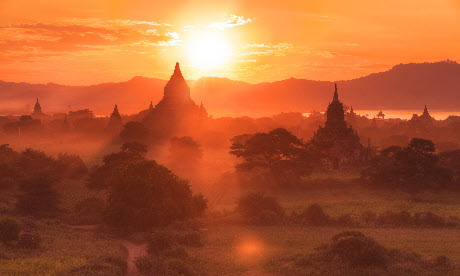
Marco Polo called it ‘one of the finest sights in the world’; you voted it ‘Top City’ – Nick Boulos discovers why Bagan is a winner in any Myanmar itinerary
The road ahead was long, straight, and lined with trees. It shimmered in the steamy morning heat. In the far distance, rising from the dusty plains, was the ancient skyline of Bagan.
Creaking with each rotation, the wheels of my rusty bicycle carried me towards the 3,000 or so stupas, pagodas and tiered temples that are scattered across the flat Burmese grasslands. I pedalled through villages where crimson-robed monks shopped at streetside stalls attended by women whose cheeks were covered in thanaka – a pale paste made from ground bark that’s said to protect from the intense South-East Asian sun. A herd of grazing goats moved south, dust gathering at their hooves.
Wondering which crumbling relic to visit first, I stopped to consult the heavily creased map enthusiastically offered by the lady at my family-run guesthouse in the nearby village of Nyaung-U – Bagan’s nearest airport. She had circled dozens of temples. Over the coming days, I cycled along the never-ending network of sandy tracks, visiting as many of Bagan’s stupendous stupas as possible. Temple fatigue? Not likely.
Located on a wide bend of the Irrawaddy River, Bagan is an essential short break on almost all Burma itineraries. And for good reason. Once a thriving city of more than 200,000 people, it’s now one of world’s greatest archaeological sites, covering an area the size of Guernsey.
The scene that awaits today is the handiwork of mighty Bagan Kings. From 1044 to 1287, an average of 20 religious buildings took shape each month; it’s estimated that more than 10,000 were built. Most have been destroyed – a result of neglect and earthquakes, the most recent of which shook Bagan in 1975. However, major restoration has returned some of the damaged monuments to their former glory.
I was admiring one deserted stupa – so small it had a number instead of a name – when a sudden rustle came from the nearby bushes. A petite chap wearing a longyi (traditional sarong) came rushing over, fumbling with a large set of keys. The caretaker unlocked the heavy gate, beckoned me into the musky interior and proudly showed off the faded murals inside. Our footsteps echoed around the cavernous chamber.
Of course, there’s more to Bagan than just its temples, which is why Wanderlust readers voted it ‘Best City’. There are villages, monasteries and mountains to explore, and some of Burma’s friendliest people to meet. Follow in the footsteps of barefoot pilgrims and scale Mount Popa; seek enlightenment at the sacred shrines of Salay; or cruise along the mighty Irrawaddy. However you spend your time in and around Bagan, just don’t rush. Hang around for a few days. You won’t regret it.
When to go: Temperatures from November to February (the best time to visit) hover around 30°C. In April-May temperatures can exceed 40°C. The rains come June-October. Local festivals often coincide with each full moon.
Visas: Required by UK nationals. Apply in advance at the Myanmar Embassy in London (19a Charles St, London W1J 5DX; www.myanmarembassylondon.com). Processing time is around seven days; visas, valid for a four-week stay in the country, cost £14.
Getting there: There are no direct flights from the UK; travel via a hub such as Bangkok. In Burma, domestic carriers Air Bagan and Air Mandalay both fly from Yangon and Mandalay to Nyaung-U airport; fares from US$116 [£70] one way. Another popular way to arrive is by boat along the Irrawaddy from Mandalay (from US$45; 9-14 hours; www.myanmarrivercruises.com).
Getting around: Cycling is a great way to get around. Bikes can be rented from most guesthouses for US$1-2 per day. Taxis and private drivers are also cheap and easily arranged.
Where to stay: Thazin Garden Hotel is a teakwood property with hushed gardens and 67 rooms, some with pagoda views; doubles from US$100.
Thiri Sandar Royal Bagan Hotel (Main Road, New Bagan) is a good budget option with basic but clean rooms; doubles from around £13.
Where to eat: San Thi Dar serves tasty fare between Old and New Bagan. The Moon Vegetarian Restaurant is a tiny eatery near Ananda Temple
Further info: www.myanmartourism.org is the official site.
Day 1: On Your Bike
There are many ways to explore Bagan – by car, horse-and-cart, on foot, by balloon, by boat – but the best mode of transport is a bicycle. Not only is it cheap, it grants easy access to the countless pathways that lead to remoter temples overlooked by the tour buses.
Concentrate on the South and Central Plains between Old and New Bagan. Visit Thambula Pahto for its old Jataka frescoes and the formidable Dhammayangyi Pahto. But also be sure to ditch the map. One of the great joys of exploring Bagan is simply heading down trails without any idea of what lies at the end. Odds are it’ll be a stupa of some sort but even so…
Some of the best temple art can be found at the 13th century Upali Thein, named after a local monk, and the 13th century Nandamannya Pahto, the walls of which are adorned with murals depicting topless women trying to tempt and distract Buddha from meditating.
Also visit the more famous sights. Chief among them is the gilded and grand Ananda, the largest of Bagan’s temples. Beyond the tall teak doors and thick walls are vaulted corridors and giant Buddha statues, up to 10m high.
Finish the day at the nearby Moon Vegetarian Restaurant to tuck into a plate of its tasty tamarind leaf curry.
It’s well worth getting up at 4am to see the sun rise over the temple-studded plains. Best is from a hot-air balloon offers tailored trips.
ATMs are relatively new to Bagan, so buy plenty of local currency at the airport (Burmese kyat) as well as US dollars in pristine condition to exchange.